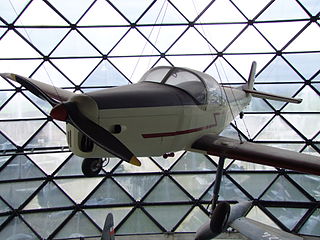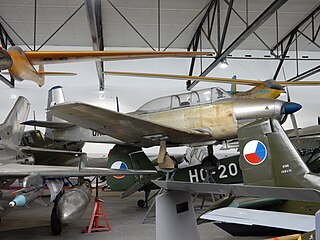Related Research Articles

The Pilatus P-2 is a trainer aircraft designed by Swiss manufacturer Pilatus in 1942 and first flown on April 27, 1945. It was used by the Swiss Air Force from 1946 until 1981. The Pilatus P-2 emerged from an unbuilt project of the Pilatus P-1, which can be seen as a single-seat version of the P-2.

The SAI KZ III Laerke was a Danish light utility aircraft used by the Danish Air Ambulance Service and Danish Air Force.

The IAR 79 was a twin-engine bomber and military reconnaissance aircraft with a wood and metal structure that saw service in World War II built under licence in Brasov, Romania, by Industria Aeronautică Română
The IAR 14 is a Romanian low-wing monoplane fighter-trainer aircraft designed before World War II.

The Caudron C.600 Aiglon is a 1930s French two-seat monoplane sport/touring aircraft built by Caudron–Renault.

The Luton Buzzard was a 1930s British single-seat, open cockpit ultralight aircraft built by Luton Aircraft Limited.

The LIBIS KB-6 Matajur was a 1950s Slovenian two-seat light monoplane designed and produced by LIBIS aircraft during Yugoslavian period.

The Colonial Model C-1 Skimmer was an American small single-engined amphibian flying boat built by the Colonial Aircraft Corporation. It was the start of a line of very similar aircraft designed by David Thurston.
The Piper PA-6 Sky Sedan was a 1940s American four-seat light aircraft designed and built in prototype form by Piper Aircraft at its Lock Haven, Pennsylvania, factory.

The SET 7 was a military trainer and reconnaissance aircraft that was produced in Romania in the mid-1930s. It was originally designed as a conventional single-bay biplane, with slightly staggered wings, a standard undercarriage with fixed tailskid, and a tandem open-cockpit arrangement for the pilot and instructor or observer. Power was supplied by an Armstrong Siddeley Jaguar radial engine, and from the outset the aircraft was equipped for wireless and photographic reconnaissance duties.

The SET 10 was a trainer aircraft produced in Romania in prototype form in the early 1930s. It was a conventional, single-bay biplane with staggered wings braced with N-struts. It was equipped with fixed tailskid undercarriage, and seated the pilot and instructor in tandem, open cockpits. Intended for Romania's aeroclubs and Air Force, no production ensued.
The SET XV was a fighter aircraft developed in Romania in the mid-1930s. It was a conventional single-bay biplane with staggered wings of unequal span braced by N-struts. It was fitted with fixed tailwheel undercarriage with spatted mainwheels. The cockpit was fully enclosed, and the engine was fitted with a NACA cowl. Construction throughout was fabric-covered metal.

The IAR-827 was an agricultural aircraft built in Romania in the 1970s and 1980s. The penultimate member of the family of designs that began with the IAR-821, it was, like the others, a conventional low-wing monoplane with fixed, tailwheel undercarriage, and shared the all-metal construction of the IAR-826. The prototype flew in 1976, powered by a Lycoming IO-720 engine, but the production examples that followed all had the PZL-3S.

The IAR-22 was a single engine basic trainer built in Romania in about 1934. It was a low-wing monoplane with two seats in tandem and a fixed conventional undercarriage.

The IAR 27 was a 1930s Romanian two-seat low-wing monoplane primary trainer designed and built by Industria Aeronautică Română.
The IAR-818 was a Romanian multipurpose aircraft based on the IAR-817. It was developed by IAR in both landplane and floatplane forms.
The IAR-817 was a Romanian multipurpose aircraft built in the 1950s.
The IAR-813 was a Romanian trainer aircraft based on the IAR-811. It differed from the IAR 811 in having a bubble canopy and more powerful engine.
The IAR-814, aka MR-2, was a Romanian designed and built twin-engined trainer aircraft built in the early 1950s, the first twin-eninged aircraft wholly designed and built in Romania.

The TOM-8 was a prototype Czechoslovak single-engined two-seat training aircraft of the 1950s. It was designed by the VZLU, the Czechoslovak national aeronautic research institute for the Czechoslovak Air Force, with a prototype flying in 1956, but production plans were abandoned in 1960.
References
- 1 2 Gugju, Ion; Gheorghe Iacobescu; Ovidiu Ionescu. Romanian Aeronautical Constructions 1905–1974. Brasov. pp. 222–223.
- 1 2 "Post-War Roumanian". Flight . Vol. LVII no. 2154. 6 April 1950. p. 424.
- ↑ Vlad 1998 , pp. 9–10
- ↑ Bridgman 1958 , p. 214
- 1 2 Bridgman 1952, p. 150
- Bridgman, Leonard (1952). Jane's All the World's Aircraft 1952–53. London: Sampson Low, Marston & Company, Ltd.
- Bridgman, Leonard (1958). Jane's All the World's Aircraft 1958–59. London: Sampson Low, Marston & Company, Ltd.
- Vlad, Danut (March–April 1998). "Out of the Ashes: The Romanian Aviation Industry Since 1945". Air Enthusiast . No. 74. pp. 9–19. ISSN 0143-5450.